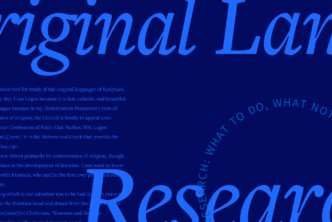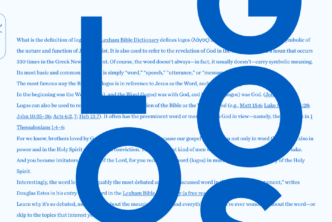
The first time I attended SBL, back in November 2015, I was fortunate to be in company with eight other colleagues who also had papers accepted. My own was co-authored with Jeremy Thompson and was presented in the Biblical Hebrew and Lexicography section. We discussed how case frame analysis can help you parse out the different meanings associated with a word.
To make our case we could have chosen an easy word like שׁוב and demonstrated that the difference between the sense of “go back” and “transfer” is the difference between the presence or absence of a moveable part (i.e., a Theme) in the sentence:
- Agent-Goal :: “go back” sense
“Then Reuben [Agent] returned to the pit [Goal]” (Gen 37:29)
- Agent-Theme-Goal :: “transfer” sense
“I [Agent] will bring you [Theme] to this land [Goal]” (Exod 28:15)
Instead, we decided to demonstrate how frame analysis can help you understand even the most difficult of verbs—ones that are abstract, like קָדַשׁ (to be holy).
While there are multiple angles from which you can study the potential usages of a word (for example, theological dictionaries), for the moment we’ll take a peek at how case frame analysis can provide a method to formalize one’s analysis.
In other words, we’ll take introspection out of the leading role and replace it with some formal criteria.
What do we mean by “formalization?”
Introspection will always have its place in sorting out the different meanings associated with a word or expression. The trouble is that anyone can posit a line of reasoning based on one’s own internal logic, and this may or may not be plausible, or even explicitly laid out to receive critical engagement.
So if we—or a lexicographer—want our analysis to be more valuable to the community that’s going to assess it, then any method that grounds our tinkering with the data in a more explicit or replicable fashion should be highly sought after.
This is why frame analysis is so attractive: it blends what can be objectively observed (the syntax or argument structure of an utterance) with what we think the construction accomplishes (its meaning). This marriage of form and meaning lies at the heart of how language works. From the morpheme to the idiom, the symbolic bond between form and meaning is inseparable (and ever-evolving).
What does frame analysis actually look like?
In my research with Jeremy, we found that frame analysis allowed us to analyze an abstract form like קָדַשׁ and get a bird’s-eye view of its different uses, as well as a more zoomed-in assessment of the different meanings associated with the form.
To give you a taste of what we found, let’s look at how frame analysis helped us tease apart two different meanings that are both expressed in an Agent-Patient frame (roughly, the actor and the acted-upon):
- Causative: when a Patient is caused to become קדשׁ
- Estimative: when a Patient is treated as קדשׁ
The main stems used in an Agent-Patient frame are the piel, hiphil, and the hithpael. Although these stems can carry their own unique force with a verb, they also share a common trait: each stem requires a Patient (again, the person, place, thing, or even time that is acted-upon).
But though the piel, hiphil, and the hithpael all require a Patient, you’d be mistaken to assume that the meaning of every expression of the Agent-Patient frame with קדשׁ is the same.
It’s true that a causative force is the most common (i.e., to consecratesomething). But what happens when the Patient is already קָדַשׁ? In such cases it’s impossible for a causative meaning to be in play.
How can something be made קדשׁ that’s already קדשׁ? In these situations, an estimative force is more likely to be at work. In other words, the Agent is described as treating or regarding the Patient as קדשׁ.
Isaiah 8:13 is a great example of this, where Yahweh is the Patient—who is already קָדַשׁ and cannot be made such by any other being. Could a mere mortal make Yahweh any more קדשׁ than he already is? No, the proper rendering, as reflected in major modern translations, is the following:
You shall regard Yahweh of hosts as holy. (LEB)
It’s significant to note that the verb is in the hiphil stem, which is commonly associated with causation—but not here.
 The takeaway
The takeaway
Instead of trying to figure out the meaning of קָדַשׁ by paying attention to the stems (which do not provide enough detail), you can follow our lead and do two things.
- We adopted a perspective of analysis that encompasses the stems used and pays attention to the actual argument structure (or semantic roles) of the utterance. In doing so, different usages are divided up by a more reliable and comprehensive method.
- We considered whether or not the Patient was holy before the Agent-Patient expression. If the Patient was already holy, then an estimative (or “treat as”) sense was most likely the best reading; whereas if the Patient was not holy before the verbal activity, then a causative force would prove to be more fitting.
By beginning our investigation of קָדַשׁ with a case frame analysis we were able to formalize our analysis in a systematic and more replicable fashion and make our reasoning transparent for the interested observer. And there’s no reason you can’t do the same thing, too.
Here’s a short training video showing you how. For other related resources, check out:
- Paul Danove’s Linguistics and Exegesis in the Gospel of Mark: Applications of a Case Frame Analysis and Lexicon
- Paul Danove’s contribution to Biblical Greek Language and Linguistics: Open Questions in Current Research, part II, chapter 3
- Mangum and Westbury’s Lexham Methods Series: Linguistics and Biblical Exegesis (especially Aubrey’s chapter 10)







